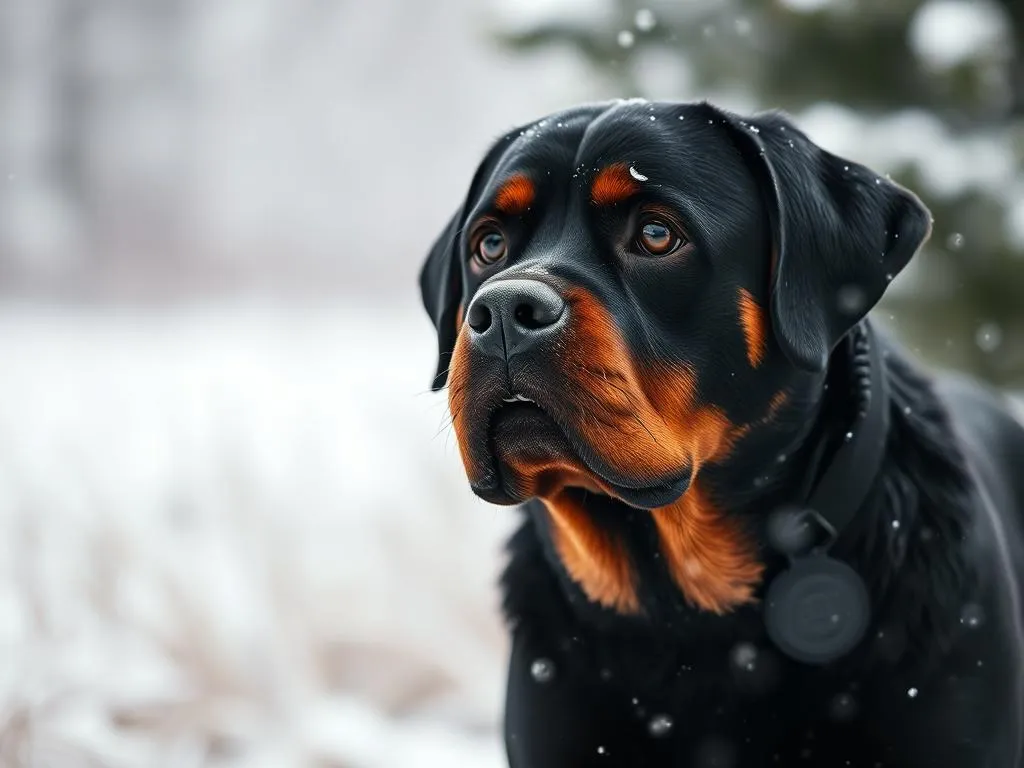
Rottweilers are known for their strength, loyalty, and versatility. As one of the most popular dog breeds, they have a rich history rooted in working alongside humans. However, for prospective Rottweiler owners or those already blessed with this breed, understanding their cold weather tolerance is crucial, especially in regions where winter brings biting temperatures. The question that often arises is: can Rottweilers handle cold weather?
Understanding Rottweilers
Breed Characteristics
Rottweilers are large, robust dogs that typically weigh between 80 to 135 pounds. Their muscular build and powerful stature make them excellent working dogs. One of the most notable features of Rottweilers is their double coat, which consists of a dense undercoat and a coarser topcoat. This coat type plays a significant role in their ability to adapt to various climates, including colder environments.
In terms of temperament, Rottweilers are known for their confidence and loyalty. They are intelligent and can be trained with relative ease, but they require consistent training and socialization to ensure they develop into well-rounded companions. Their protective nature makes them great family pets, but it also means they need proper exposure to different environments and people from an early age.
Origin and Historical Background
The Rottweiler’s lineage dates back to ancient Roman times when they were used as herding dogs. Their ability to work in various climates helped them adapt to the diverse environments they encountered. Originally bred to drive cattle and later used for pulling carts, their robust body structure and strong work ethic made them invaluable in various roles. Over time, Rottweilers have evolved, but their historical adaptability to different climates remains a testament to their resilience.
Cold Weather Tolerance in Dogs
Factors Influencing Cold Weather Tolerance
When evaluating if Rottweilers can handle cold weather, several factors come into play:
-
Coat Type and Insulation: Rottweilers’ double coat provides a significant level of insulation, making them better equipped to handle colder temperatures than many other breeds. However, this does not mean they are immune to the cold.
-
Body Fat and Muscle Mass: A healthy layer of body fat and muscle mass contributes to a dog’s ability to retain heat. Rottweilers typically have a well-muscled build, which aids in their cold weather endurance.
-
Age and Health Status: Younger and healthier Rottweilers are generally more adaptable to extreme weather conditions. Older dogs or those with health issues may struggle more and require additional care.
Signs of Cold Stress in Dogs
Even the most resilient dogs can succumb to cold stress. It’s essential to be observant of your Rottweiler’s behavior and physical state during colder months:
-
Behavioral Signs: Shivering, lethargy, and reluctance to engage in outdoor activities can indicate cold stress. If your Rottweiler seems unusually quiet or wants to go indoors, it might be feeling the chill.
-
Physical Signs: Look for signs like lifting their paws off the ground, whining, or showing discomfort when walking on cold surfaces. These behaviors can indicate that the cold is affecting them physically.
Rottweilers and Cold Weather
Coat and Body Characteristics
Rottweilers possess a double coat that offers some insulation against cold weather. The undercoat is thick and dense, while the outer coat repels moisture. This natural protection allows them to handle moderate cold, but it’s essential to monitor them as temperatures drop.
Compared to breeds known for cold tolerance, such as Siberian Huskies or Alaskan Malamutes, Rottweilers are not as adept in harsh winter conditions. While they can handle cooler temperatures, they should not be exposed to extreme cold for prolonged periods.
Ideal Temperature Range for Rottweilers
Generally, Rottweilers are comfortable in temperatures ranging from 20°F to 50°F (-6°C to 10°C). However, when temperatures dip below this range, their tolerance diminishes. It’s vital to recognize the signs indicating when it’s too cold for them. If outdoor activities are met with shivering, reluctance to go outside, or signs of distress, it’s time to retreat indoors.
Preparing Rottweilers for Cold Weather
Clothing and Accessories
When it comes to ensuring your Rottweiler’s comfort in cold weather, investing in proper clothing and accessories is key. Here are some recommendations:
-
Dog Coats: Look for insulated coats that cover the chest and back. Coats with adjustable straps will help ensure a snug fit, preventing cold air from seeping in.
-
Boots: Dog boots can protect their paws from ice, snow, and salt. Ensure they fit well and are comfortable for your Rottweiler to wear. Gradually introduce them to the boots indoors before venturing outside.
Indoor Care
While Rottweilers can adapt to cold weather, it’s essential to keep them warm indoors during the winter months. Here are a few tips:
-
Warm Sleeping Area: Provide a cozy bed in a warm part of the house. This helps them maintain body heat while resting.
-
Hydration and Nutrition: Ensure your Rottweiler stays hydrated. Cold weather can sometimes reduce their thirst, so encourage them to drink water. Additionally, consider adjusting their diet to include more calories, as they may burn more energy to stay warm.
Outdoor Activities in Cold Weather
Safe Winter Activities
Rottweilers love to play, even in winter. Here are some suggestions for safe outdoor activities:
-
Short Walks: Opt for shorter walks during the coldest parts of the day. Keep an eye on your Rottweiler for any signs of discomfort.
-
Interactive Play: Engage in games like fetch in the snow, but monitor their behavior. If they seem to tire quickly, it may be a sign to cut the activity short.
Hiking and Adventures in Cold Weather
For those who enjoy hiking, taking your Rottweiler on winter trails can be an exciting adventure. Here are some tips to ensure safety during such outings:
-
Trail Selection: Choose trails that are safe for dog travel and avoid areas prone to extreme weather conditions.
-
Supervision: Always keep your Rottweiler on a leash. Snow can cover potential hazards, and it’s crucial to maintain control in unfamiliar terrain.
Common Misconceptions About Rottweilers and Cold Weather
Myth-Busting
There are many myths surrounding Rottweilers and their ability to handle cold weather. One common misconception is that their thick coat makes them impervious to cold. While their coat does offer some protection, it’s essential to remember that all dogs have limits.
Another myth is that Rottweilers do not require additional warmth indoors during winter. In reality, they benefit from a warm, dry environment, especially as they age.
Real-Life Examples
Rottweiler owners in colder climates often share experiences of their dogs adapting beautifully to winter. Many report that their Rottweilers thrive in the snow, playing joyfully and enjoying the cold weather. However, they also emphasize the importance of monitoring their pets closely to prevent any cold-related issues.
Conclusion
Understanding whether Rottweilers can handle cold weather involves recognizing their adaptability and limitations. Their double coat provides them with a level of insulation, but it’s crucial to monitor their behavior and health as temperatures drop. With proper preparation, including clothing, indoor care, and safe outdoor activities, Rottweiler owners can ensure their dogs remain happy and healthy during the colder months.
As responsible dog owners, it’s our duty to prioritize our Rottweilers’ well-being, adapting our routines to accommodate their needs in winter. Share your experiences with Rottweilers in winter conditions and help create a community of informed and caring owners!









